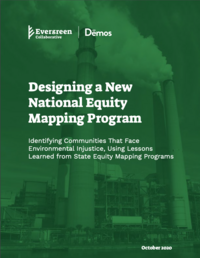Introduction
Environmental racism has devastated communities across the United States for generations— from slavery, through Jim Crow, redlining, and decades of forced segregation. In many cases, environmental injustice represents deeper patterns of unequal access to political power, justice, and capital, resulting in systemic exposure to the harms of economic activity, even as the benefits of the corresponding prosperity were withheld. The facts are indisputable. One recent study found that “redlined” communities—those that were historically excluded from fair and affordable home ownership and denied access to credit—see 2.4 times the rate of hospital admissions for asthma as do non-redlined communities in the same city. People of color disproportionately live in neighborhoods located near toxic release facilities. And federal environmental policies continue to discriminate—for example, after storms and other disasters, the Small Business Association approves rebuilding-assistance loans at nearly twice the rate in white neighborhoods as in Black neighborhoods. And the Trump Administration doggedly weakens environmental laws, like the National Environmental Policy Act (NEPA), that attempt to protect the most vulnerable communities from toxic pollution and environmental exploitation.
Download the full report PDF
Because of structural racism and institutional inequity, Americans in communities of color and low-income communities face huge obstacles as they attempt to build healthy lives and thriving livelihoods. As the United States prepares for a future fundamentally marked by climate instability, it is an economic and moral imperative to build true climate justice today.
Several states (California, New York, Washington, and Maryland, in particular) have already adopted (or are adopting) an Equity Map, which is a critical tool for helping to identify these disadvantaged communities. To confront these challenges at the federal level, the Evergreen Action Plan similarly calls for the next Administration to launch a new federal Equity Mapping initiative to track the cumulative impacts of exposure to pollution, health disparities, and economic inequality, and to ensure that future climate-led investments are distributed equitably. Demos likewise proposes Equity Mapping of vulnerable communities as part of a Climate Equity Accountability System in its Frontlines Climate Justice Executive Action Platform. Following the example of states engaged in this work, the federal government should determine which communities experience the most harm in order to ensure that policy implementation prevents further inequality and remediates historic harms.
An effective Equity Map gathers data about environmental exposures and demonstrates how those exposures are distributed spatially and geographically and how they overlap and interact with other health, economic, demographic, and social vulnerabilities each unique community faces. It then displays that information on cumulative impacts in ways that help policymakers understand where the hardesthit communities are located.
A tool like this, known as EJSCREEN, already exists at the federal level. However, its current capabilities are insufficient to effectively inform equitable policy implementation. For instance, EJSCREEN does not analyze the cumulative impact of how pollution intersects with social and economic disparities, nor is it constructed or used to inform federal decision-making on a proactive basis. Moreover, the federal government too often falls short in forming trusted relationships with impacted communities, in gathering data to inform a truly effective Mapping effort, and in leveraging the technical expertise and existing data sets currently housed across the federal bureaucracy to better understand and utilize this information to improve decisions and achieve better economic and health outcomes for communities.
With a more robust and carefully constructed Equity Mapping Program in place, the federal government could jumpstart the path to climate justice. As early efforts in key states have shown, an effective Equity Mapping Program could build the relationships, data, and accountability needed to more accurately identify which communities have faced the greatest harm from environmental impacts and from structural inequities. It could then direct resources to remedy those harms at the community level and prevent policies from causing further injury. And this initiative is popular—polling from Data for Progress shows that 67% of voters support a federal Equity Mapping initiative. This memo explores state-level Equity Mapping efforts to date, and explains how a new national Equity Mapping Program could realize far greater public benefit for all people.
Part I examines how states have defined which harms characterize a community (as explained in the definitions section, this is a term-of-art used within this policy space, not a term of our choosing) and how states have used Equity Maps to identify and locate those communities. Part II discusses the limitations of EJSCREEN, the currently analogous federal program. Part III suggests that, like the states, the federal government should define disadvantaged communities by the cumulative impact of environmental harms and socioeconomic disparities. It then describes how a new federal Equity Mapping Program could be designed. And Part IV discusses how this strengthened Map should be used to advance environmental justice proactively nationwide.
An Equity Map is important, but not in itself sufficient, to ensure that disadvantaged communities receive the investments that justice demands. Rather, establishing a national Equity Mapping Program must also be accompanied by policies and budget commitments that put this information to work to screen federal investment and decision-making to help the federal government direct resources to the places that need them most.
Download the full report PDF to read more

